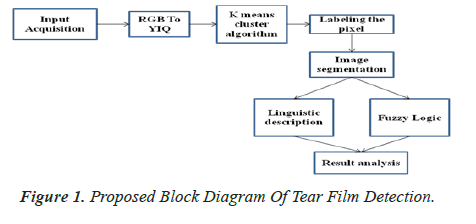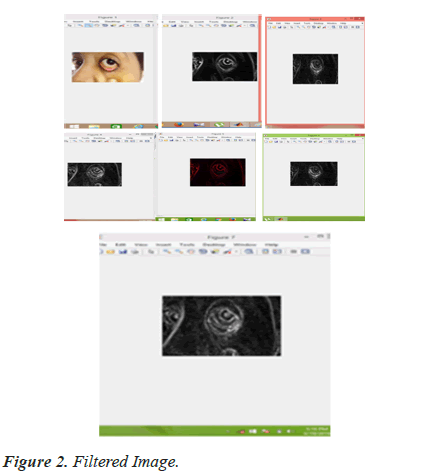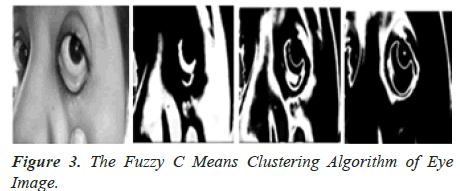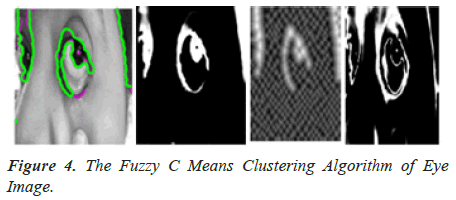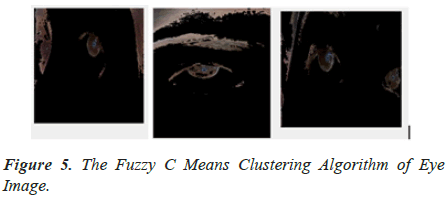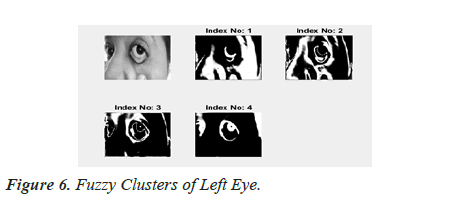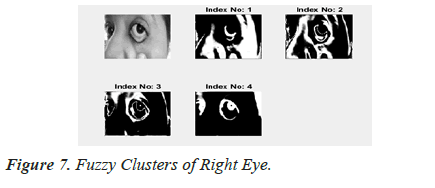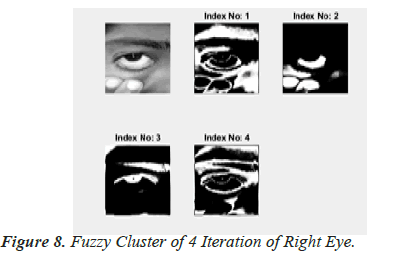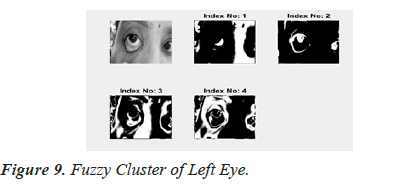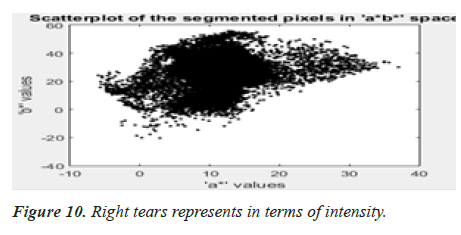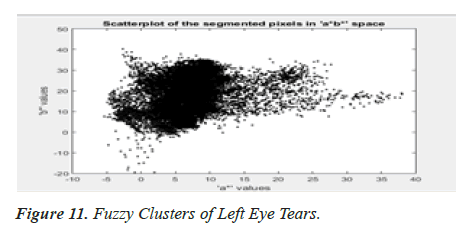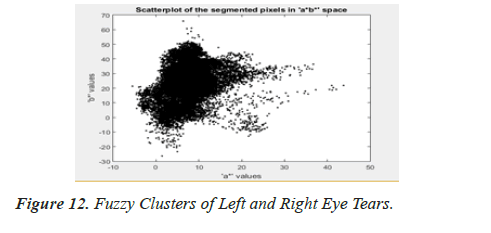ISSN: 0970-938X (Print) | 0976-1683 (Electronic)
Biomedical Research
An International Journal of Medical Sciences
Research Article - Biomedical Research (2021) Biomedical and cellular systems for diagnostic and therapeutic purposes
Non-invasive Dry Eye detection using Fuzzy c-means Clustering Algorithm
1Department of ECE, Rajalakshmi Institute of Technology, Chennai, India
2Department of ECE, Vel Tech High Tech Dr Rangarajan Dr sakunthala engineering college, Avadi, Chennai, India
3Department of ECE, Vel Tech Multi Tech Dr Rangarajan Dr sakunthala engineering college, Avadi, Chennai, India
- Corresponding Author:
- Prabhakaran N
Department of ECE,
Vel Tech High Tech Dr Rangarajan Dr sakunthala Engineering College
Avadi
Chennai
India
Accepted on May 18, 2020
The background includes the study area of the dry eye taken from 75 patients to analyze eye-related disease. This method suggested as earlier detection of eye detection and tries to diagnose the problem. Early detection of eye problem helps the patient to have a clear line of sight distance through fuzzy c means clustering algorithm.The tear film must be detected at an early stage to protect the person from death. The tear film should be a monitor at the initial stage and diagnose by the unique technique, whether it may be the invasive or non-invasive method of dry detection. The invasive approach is the time-consuming process, and many disadvantages in this method arise in tear film detection. The non- invasive technique is not said to be a slow process. So the author proposed the novel approach of tear film detection by fuzzy c means clustering algorithm. The sample of eye images are taken and processed with fuzzy c means clustering algorithm and finds the intensity in both the eye. The accuracy analysis carried by fuzzy c indicates a clustering algorithm of 82% in its efficiency.
Keywords
Dry eye syndrome, Invasive and on invasive method, Fuzzy c means clustering, Accuracy.
Introduction
TDry eye syndrome causes a normal or abnormal person, who doesn't have enough quality of tears to lubricate and nourish the eye. The dry eye syndrome is necessary to monitor the eye disease in the early stage of diagnosis and provide a clear vision. The Dry eye is a chronic problem for older adults aged around 60-70 years. Blink of eyelids analyzes how the water levels present in the eye. However, when you open and close the eye, the tear is present in the eyelid. The Tears provide lubrication and reduce eye infection which leads to a clear vision of the particular object. The tears present in the inner corners of the eyelids are sufficiently enough then the eye-related disease is less. Moreover, the tear present in the eyelid is excess and frequently excess of a tear in the eye, it leads to a brain-related problem. Therefore, the dry eyes occur both in the inner eyelid and outer eyelid. The tear production diminishes with age, under various medical conditions or as more side effect. The Environmental condition such as wind and dry climates causes a decrease in tear film volume due to increased tear evaporation. The average level of tear production decreases or evaporates too quickly from the eyes, and it is the major symptoms of dry eye. The tears in the eye classified as oil, water and mucus respectively. The smooth oil layer helps to prevent evaporation of the water layer, while the much in layer spreads the tears on the surface of the dry eye. The tears evaporate quickly and do not spread over the cornea. The dry eyes occur when the water layer of tears is inadequate in its lipids. People with Tear eyes experience irritated, scratchy or burning eyes. The Advanced dry eyes damage the front surface of the eye-related disease and vision. Many treatments for dry restore and maintain average tears in dry eye syndrome. To minimize the dryness related discomfort and to maintain a healthy condition the fuzzy c means clustering algorithm applied to eye image for the patient who is suffering from eye problem.
The fuzzy c means clustering algorithm optimizes the eye image and clusters the image concerning true positive and true negative. The pixel with true positive indicates the level of dryness and pixel with true negative, the level of tears is excess. To maintain the water level average in both eyes certain precaution must be taken and prevent eyerelated disease. Moreover, the fuzzy c means clustering algorithm optimizes the dry eye in the early stages of diagnosis. The algorithm clusters the eye image for the position, velocity and dimension of each cluster present in the dry eye. The optimization algorithm predicts accurate analysis and water level present in both eyes of the patient suffering from dry eye syndrome.
Related Work
TThe analysis of meibomian gland area evaluates the luminance by enhancing the contrast also well defined, and the image noise s automatically reduced in this process of developing the software. Meanwhile, the meibomian gland area evaluates the treatment of dysfunction [1]. Glaucoma is a non-curable disease authorized by the people. Glaucoma can be detected on a cup to disc ratio using fuzzy c means clustering algorithm. The image captured identified from the colour whether the disease in early, moderate and severe. The condition detects at an early stage by the cup to disc ratio of fuzzy c means clustering algorithm [2]. Automatic detection of eye problem arises from the itching the eye from the ocular surface of the retinal region. The fluorescing liquid is dropped on the ocular surface from the lower eyelid to upper eyelid and locates the problem in the iris. The novel RANSAC method proposed to overcome the disease identified automatically [3]. Due to the increase in the fluorescent liquid cause’s damage in the ocular surface area and a decrease in the fluorescein liquid, the cost is very less. So there is the insulation of liquid level proposed by the author will not damage the ocular surface area. So there is a break up analyzed in the fluorescent level [4]. The noninvasive tear film method proposed to identify the disease in the early stage. The process tested with the device, and it takes time with the prospective output for nearly two weeks. The major disadvantage in the proposed method. Some other technique needs to introduce and detect inevasible tear film break up time as the limiting factor [5]. Videokeratoscopy is a high-speed technique to analyze the dry problem in the early stage of the diagnostics method. The on the invasive process of haemostatic can e cured at the initial step. So the novel method is proposed to analyze the haemostatic in the first stage of tear film break up time [6]. Two unique way BU and BUT suggested to explain which method efficiently improves the result in dry eye monitoring the ocular surface area. The two methods concentrate on the lipid layers, which can e diagnosed at the early stage [7]. Experiments demonstrate the robustness of the proposed method, which outperforms to create tear film and provides accurate results in comparison with clinicians. The proposed method helps to promote its clinical use for diagnosis and treatment [8]. The proposed method is to train deep convolution neural network for automatically detecting the punctuate dots in the ocular surface. And then we obtain a value, called CNN-SPK value, which represents the coverage of punctuating dots to improve the efficiency of the dry eye diagnosis treatment [9]. Computer-aided detection s preferred for Dry eye diagnosis. The CAD techniques automatically diagnose the DED and focus on thermographic CAD systems. The CAD systems for DED thermograph found to be highly sensitive. Furthermore, the deep learning techniques rediscussed to conventional machine learning techniques in dry eye detection [10].
Methodology
The computerized test introduced in a real-time situation is the cost-effective test but requires less processing time to show the accurate result about the disease present in the eye. The proposed method is the noninvasive method of dry eye detection using fuzzy c means clustering algorithm. Furthermore, without any computer or any other hardware devices is not necessary and at the same time, the problem related to dry eye is detected and it can be diagnosed at the early stage. In the existing method, the error ratio cannot be predictable at the early stage of diagnosis and timeconsuming process. The patient with dry eye syndrome has to wait for nearly 2 to 3 working days to get the result of the disease. But fuzzy c means algorithm, cluster the image for the pixel with true positive of true negative indicates the level of water or intensity present in the eye image. The future development in dry eye syndrome help the government to design a non-invasive method of dry eye disease with the low-cost compatible device using fuzzy c means clustering algorithm is proposed. Figure 1 represents the proposed block diagram of dry eye detection using fuzzy c means algorithm used in the early stage of diagnostics. The input image (eye image) is the acquisition tool to be processed to analyze the tear film in the input itself. If the tear film is not analyzed in input, to converts the image RGB into luminance and chrominance value of the input black and white image. The input image (black and white) with the necessary values of the pixel represents the water level intensity. The pixel with 0 and 1 analyze the true positive or true negative processed via fuzzy c means clustering algorithm. The algorithm finds the pixel with particle logic value identify the tear film in the eye image. The pixel with 0 should be label and unlabelled to detect the presence of tear film. After segmented of eye image, it compares with linguistic with fuzzy logic. If both values are same, the tear is well delineated in fuzzy c means clustering algorithm.
Result and Discussion
From Figure 2 the exact block diagram representation is shown with a patient suffering from dry eye syndrome. At first, the input image is processed in image acquisition toolbox to overcome dry eye syndrome. Then the image is processed with YIQ to process black and white image. Afterword's segmentation of dry eye is analyzed and the variable is compared with linguistics variable achieves the best result of the comparison of required tear-film in the input stage of diagnostics (Table 1 and 2).
| S.No | Cluster Size | MEAN | S.D | Precision | F measure |
|---|---|---|---|---|---|
| 1 | 1ST CLUSTER | 7.12 | 21.22 | 0.11 | 1.32 |
| 2 | 2ND CLUSTER | 8.32 | 27.99 | 0.56 | 1.44 |
| 3 | 3RD CLUSTER | 8.98 | 31.23 | 0.79 | 1.76 |
Table 1. The statistical parameter represents the dry eye syndrome in the left eye.
| S.No | Cluster Size | MEAN | S.D | Precision | F measure |
|---|---|---|---|---|---|
| 1 | 1ST CLUSTER | 9.14 | 30.21 | 2.22 | 1.89 |
| 2 | 2ND CLUSTER | 10.32 | 32.78 | 3.22 | 1.92 |
| 3 | 3RD CLUSTER | 11.72 | 37.89 | 4.12 | 2.11 |
Table 2. The statistical parameter represents the dry eye syndrome in the right eye.
Fuzzy output
The fuzzy algorithm optimizes the search result through the pixel with the label and unlabeled data as shown in Figure 3. In figure 3, the fuzzy partition 3 cluster point to identify the water intensity level present in the image. The clustered point differentiates the level of optimization of dry image.
Deep segmented output
The fuzzy algorithm optimizes deep segmented search result through pixel with the label and unlabeled data as shown in Figure 4. In figure 4, the fuzzy optimization algorithm partitions the cluster point to identify the water intensity level present in the image. The clustered point differentiates the level of optimization of dry image. Here the water level is low then it identifies the type of disease. Moreover, if the water level is high it identifies the type of disease compared with low. The disease identifies only with deep segmented images.
Working model 1 output
The algorithm optimizes the working model 1 result through supervised and unsupervised learning as shown in Figure 5. In figure 5, the fuzzy optimization algorithm partitions the cluster point to identify the water intensity level present in the image. The clustered point differentiates the level of optimization of dry image. Here, the water level is low then it identifies the type of disease. Moreover, if the water level is high it identifies the type of disease compared with low. The disease identifies only with deep segmented images.
Working model 2 output
The algorithm optimizes the working model 1 result through supervised and unsupervised learning as shown in Figure 6. In figure 6, the fuzzy optimization algorithm partitions the cluster point to identify the water intensity level present in the image. The clustered point differentiates the level of optimization of dry image. Here, the water level is low then it identifies the type of disease. Moreover, if the water level is high it identifies the type of disease compared with low. The disease identifies only with deep segmented images.
Working model 3 output
The algorithm optimizes the working model 1 result through supervised and unsupervised learning as shown in Figure 7. In figure 7, the fuzzy optimization algorithm partitions the cluster point to identify the water intensity level present in the image. The clustered point differentiates the level of optimization of dry image. Here, the water level is low then it identifies the type of disease. Moreover, if the water level is high it identifies the type of disease compared with low. The disease identifies only with deep segmented images.
Working model 4 output
The algorithm optimizes the working model 1 result through supervised and unsupervised learning as shown in Figure 8. In figure 8, the fuzzy optimization algorithm partitions the cluster point to identify the water intensity level present in the image. The clustered point differentiates the level of optimization of dry image. Here, the water level is low then it identifies the type of disease. Moreover, if the water level is high it identifies the type of disease compared with low. The disease identifies only with deep segmented images.
Working model 5 output
The algorithm optimizes the working model 1 result through supervised and unsupervised learning as shown in Figure 9. In figure 9, the fuzzy optimization algorithm partitions the cluster point to identify the water intensity level present in the image. The clustered point differentiates the level of optimization of dry image. Here, the water level is low then it identifies the type of disease. Moreover, if the water level is high it identifies the type of disease compared with low. The disease identifies only with deep segmented images (Figures 10-12).
Conclusion
The automatic detection of tear film developed will be tested on real-time data sets and provides a comprehensive evaluation using fuzzy c means clustering algorithm. The fuzzy c means clustering algorithm optimizes the eye image and finds the water level in both the eye and diagnosis in the early stages. The statistical parameter accuracy obtains about 85% of the true result without any error.
The technique is clinically useful for the optometrists. The long term goal is to implement a non-invasive method to detect the stability of the tear film automatically.
References
- Arita R, Suehiro J, Haraguchi T, Shirakawa R, Tokoro H, Amano S. Objective image analysis of the meibomian gland area. Br J Ophthalmol 2014; 98: 746-755.
- Barman K, Sarma P. Glaucoma Detection Using Fuzzy-C Means Clustering Algorithm and Thresholding. Int J Comp Sci Eng 2019; 3: 859-864.
- Jiang S, Counsell SJ, Xue H, Allsop JM, Rutherford MA, Rueckert D, Hajnal JV. In-utero 3D high resolution fetal brain diffusion tensor imaging. Intl Soc Mag Reson Med 2007; 15: 661.
- King-Smith PE, Ramamoorthy P, Braun RJ, Nichols JJ. Tear film images and breakup analyzed using fluorescent quenching. Invest Ophthalmol Visual Sci 2013; 54: 6003-6011.
- Lee R, Yeo S, Aung HT, Tong L. Agreement of noninvasive tear break-up time measurement between Tomey RT-7000 Auto Refractor-Keratometer and Oculus Keratograph 5M. Clin Ophthalmol 2016; 10: 1785.
- Llorens-Quintana C, Szczesna-Iskander D, Iskander DR. Supporting dry eye diagnosis with a new method for noninvasive Tear film quality assessment. Optomet Vision Sci 2019; 96: 103-110.
- Christopher AM. Public Access: Physiological Behavior. 2016.
- Remeseiro B, Mosquera A, Penedo MG. CASDES: a computer-aided system to support dry eye diagnosis based on tear film maps. IEEE J Biomed Health Informat 2015; 20: 936-943.
- Su TY, Ting PJ, Chang SW, Chen DY. Superficial Punctate Keratitis Grading for Dry Eye Screening using Deep Convolutional Neural Networks. IEEE Sensors J 2019; 2: 1.
- Vicnesh J, Oh SL, Wei JK, Ciaccio EJ, Chua KC, Tong L, Acharya UR. Thoughts concerning the application of thermogram images for automated diagnosis of dry eye-A review. Infrared Phys Technol 2020; 8: 103271.
